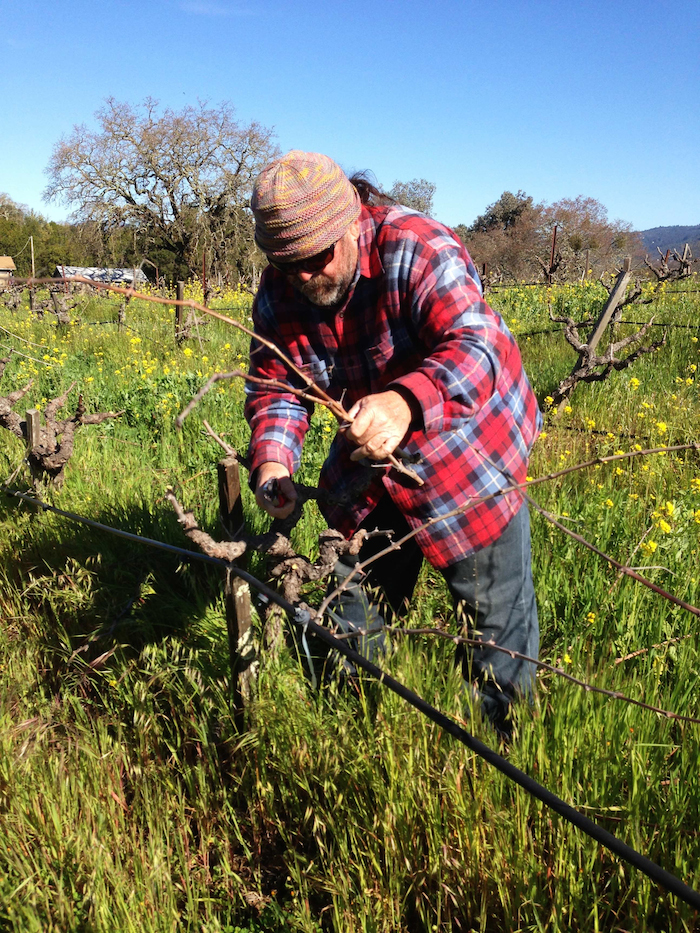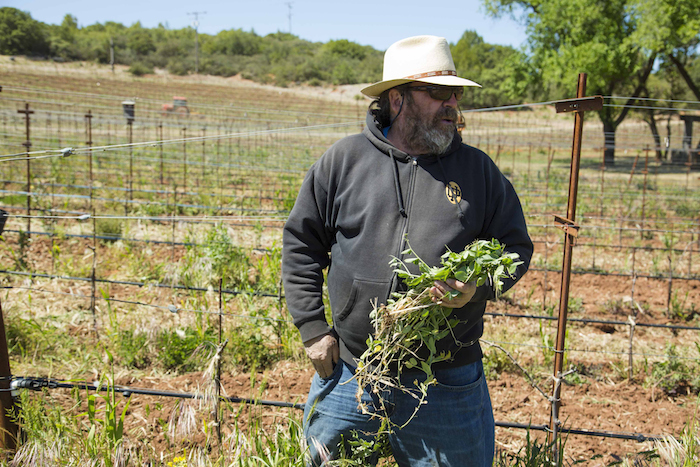All the many reasons why Phil Coturri covers his crops.
April 1 is an auspicious day to meet famed organic grape grower Phil Coturri, because April 1 is the day that Coturri makes his twice-yearly switch in practice.
“Growing grapes is a monoculture,” he instructs, standing on the rocky, volcanic soil of a vineyard adjacent to his home high in the newly established Moon Mountain District AVA above the town of Sonoma. “And monoculture is the worst kind of farming that there is. My philosophy is that from April1 to November 1, I grow grapes. And from November 1 to April 1, I grow cover crops. I break the monotony of a monoculture by seeding and harvesting other plants out here, and I’m harvesting in such a way that I’m feeding them to the soil.”
I break the monotony of a monoculture by seeding and harvesting other plants out here. ~ Phil Coturri
Feeding and growing soil is quite literally the bedrock of Coturri’s career. Under his Enterprise Vineyards brand, he oversees 32 vineyard parcels for some 40 wineries, including Hamel Family, Benziger, Kamen, Stone Edge Farm, his own new Sixteen 600 label, and for other celebrated vintners.
Possibly one of the most expensive growers in the business—his management fees are reportedly somewhere in the realm of $7,000 an acre—Coturri easily receives what he asks because he consistently delivers the North Bay’s best grapes. And to Coturri’s eye, these grapes are as good as they are because he spends six months of each and every year ensuring that the soil they spring from is the healthiest it can be.
On this recent first day of April, Coturri and his son Sam have brought a visitor up to a new grape stand in the lee of their Sixteen 600 property, where the family lives and tends their own modest vineyard. Just leased from their neighbor, the land Coturri is striding exemplifies the benign neglect that, aided by liberal doses of Roundup, brings him as close to rage as he might dance.
Organic farming, just to be entirely clear, has nothing at all to do with practices that have been fallaciously termed “benign” and even less to do with neglect.
This one-and-a-half acre parcel was once the bane of Coturri’s day as he passed through his own gate. Leasing it last year and planting it mostly to Grenache, he is now setting out to ferociously lavish it with the attention he believes that the land needs in order to grow his standard of fruit. There’s not a single benign or neglectful thing about it.
“I want to grow great wines,” Coturri says. “I want to grow real wines that express terroir. And it’s really hard to do, it’s really hard to have the dedication. It’s a lot easier to come out here and spray all of that Roundup. But what’s the consequence to that? There was just a big article that came out about it.” He points vigorously up the road to his neighbor’s home, where the guy who’s leasing him this land lives. He lets loose an easy laugh. “And I’m going to print it up and pin it to his gate, where it talks about how Roundup has been linked as a carcinogen to cancer.”
Instead of adding poison to the land to kill weeds, Coturri put down 150 pounds of cover crop seed on each acre, estimating that he creates some 20 tons of “green manure” whose roots will hold the soil, and whose plant waste, once the spader and harrow have done what work they can here, will create new soil. Vigorous new plantings, like clover, will choke out noxious weeds and provide nutrients while preventing more loss of the small amount of topsoil on this previously neglected parcel.
“In developing a new vineyard, I believe in cultivation, incorporating the cover crop into the soil, roots and all,” Coturri says. “I use a proprietary blend on land like this that we’ve developed over the years, and I always use a cereal grain because a cereal grain uses up more nitrogen as it breaks down than it gives up, it’s like a time release for the plants, and then I use a brassica of some sort, a mustard or a radish, because it creates pathways of opening up the soil.”
Coturri also worked with an engineer, as he always does, to protect what soil the vineyard already had. “We reshaped the terraces to make it farmable and for erosion and so I could get a tractor through here,” he says. “The [neighbor] just does stupid things, and I wanted to soften it up and get some uniformity out here. You’ll see a real transformation in a couple of years.”
All of the land that Coturri works is certified organic or Biodynamic or is in the process of becoming so. “Our farming practices don’t change whether we’re certified or not,” he says. “We’re farming with the same level of intensity.”
Growing up in San Francisco and then Glen Ellen in the ’60s, Coturri got the organic bug early, reading Organic Gardening magazine when he was just 14. He’s still learning.
“Every year, I have an aha moment about what we do out here,” he says. “I’ll be 63 this year, so it was almost 50 years ago that I started thinking about cover crops. There are stories that they told me like, ‘as the vine grows, so the terrace grows.’ The plot that you’re farming starts to define itself. It’s a slow process. These are tenets I learned as a kid, but I didn’t really know what they were.”
Thinking back to his youth, he continues. “I sprayed Paraquat on vineyards without any safety equipment—I didn’t know what the hell I was doing. It was my summer job. I’ve seen this wine industry evolve and we’ve gotten a lot better. I got really into cover crops and when I was doing that, people like Bob Cannard [of Green String Farm] were growing vegetables. Bob Cannard is a good friend of mine and he hates grape vines, because it’s a monoculture, and we argue all the time. But we started using ideas that we learned from that Back to the Earth movement that was a product of the ’60s, combined with people wanting to have vineyards. Adding the two together is how I designed my philosophy for what I do.”
And Coturri is nothing if not philosophical. He quotes the poet Gary Snyder when discussing his mandate to protect the watershed that runs from his AVA down to the Richardson Bay spread below him. He talks about striking a balance in nature. He cites neo-futurist architect Buckminster Fuller. He underscores the importance of place. And, above all, he returns to the soil.
“Soil is alive,” Coturri says. “Soil is a living organism. Soil isn’t just what I grow in. It’s part of what I grow.”
Article Resources:


